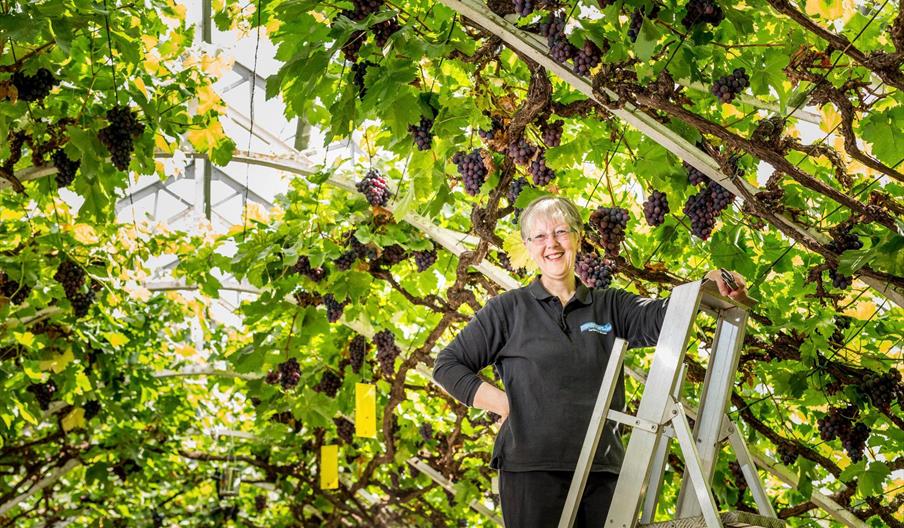
About
The Great Vine, Vitis vinifera 'Schiava Grossa' (synonym: Black Hamburg), is now 250 years old and is the largest grape vine in the world. It was planted in 1768 while Lancelot 'Capability' Brown was in charge of the gardens at Hampton Court.
THE HISTORY OF THE GREAT VINE
Lancelot 'Capability' Brown directed the planting of the Great Vine from a cutting taken at Valentines Mansion in Essex.
In 1887 it was already 1.2 metres (4') around the base. It is now four metres (13') around the base and the longest rod is 36.5 metres (120').
The Vine is grown on the extension method where one plant fills a glasshouse, as Victorian gardeners thought this method would produce a larger crop.
The average crop of black dessert grapes is about 272 kilograms (600lbs), however in the autumn of 2001 it was 383 kilograms (845 lbs) - the best crop ever. The grapes are ripe after August Bank Holiday and are sold during the first three weeks of September in the palace shop.
Queen Victoria had grapes from the Great Vine sent to the Royal Household at Windsor or to Osbourne House on the Isle of Wight. The decision to allow them to be sold to visitors was made by Edward VII, who decided the Royal Household no longer needed them. Later they were sold in small wicker baskets at St. Dunstans, the home for soldiers blinded in the First World War.
In the Second World War German P-O-Ws were given the task of thinning out the bunches of grapes.
The Vine grows on the site of the first greenhouse at Hampton Court. There have been five or six glasshouses on the site throughout its history.
In the early 1900s a three-quarter span wooden glasshouse was built which was a new shape and quite different from what existed before, as this one incorporated a viewing area for the public.
In 1969 a new glasshouse was needed. By that time, the Vine had become so entwined in the existing structure the only way forward was to build a new aluminium glasshouse over the old wooden one. The dormant vine was protected by polythene sheeting and the old glass and its supporting wooden frame was removed, leaving the iron framework of the 20th-century structure and the Vine in place.
CULTIVATION OF THE GREAT VINE
In February the buds begin to break. A fertiliser is applied to the soil inside the glasshouse and the vine border outside. Once the new shoots are 2.5-5cm or so long, it is time for disbudding to reduce the number of new shoots. The remaining shoots grow until they are 30-45 cm (12"- 18") long. They then have their growing point pinched out and are tied in with raffia.
Immediately after flowering, the number of bunches are reduced and the remaining bunches are thinned. During the growing season the Vine is given liquid and foliar feeds. Later in the summer some leaf thinning is carried out to allow sunlight to fall upon the ripening fruit. In November and December when the plant is fully dormant, the fruiting spurs are pruned back to one or two buds.
Book Tickets Online
Map & Directions
Road Directions
By Car:
The palace is located on the A308 and is well signposted from all the major local roads. From the M25 take either exit 10 on to the A307 or exit 12 on to the A308. From the A3 and then the A309.
Car Parking
Limited parking is available. During our busy periods it is advisable to consider other means of travel.
Accessible parking
There are 9 disabled parking bays available on site. Parking on site is free for Blue Badge holders.
On-site
£1.60 per hour (car parking bays fit a standard car only). Pay for your parking with cash or card.
Public Transport Directions
By Train:
South West Trains run services direct from London Waterloo to Hampton Court. The journey takes only 35 minutes and the palace is a 2-minute walk across the bridge from the station. Hampton Court station is in zone 6. Oyster cards are accepted on this route.
By Bus:
From Kingston - 111*, 216*, 411*, 461, 513 From Richmond - R68* *These services accept Oyster cards, LT cards, bus passes, Travelcards, Freedom Passes and Saver Tickets.
By Minibus/coach:
Drop-off and collection points: - Hampton Court Green (500 metres from entrance). - Hampton Court Station Coach Park (200 metres from entrance).
By River boat:
From Richmond or Kingston with Turk Launches (April - mid September) and from Westminster with Westminster Passenger Cruises (April - September).
On-site
£1.60 per hour (car parking bays fit a standard car only). Pay for your parking with cash or card.
Nearby
Hampton Court Green (500 metres from entrance) - £1.50 per hour Hampton Court Train Station (200 metres from entrance) - For information about prices, please visit the National Rail website.
Accessible by Public Transport.



 to add an item to your Itinerary basket.
to add an item to your Itinerary basket.




